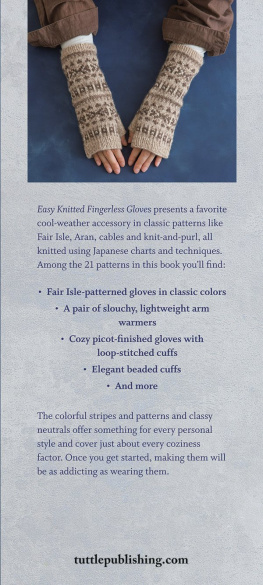Nihon Vogue - Japanese Wonder Knitting: Timeless Stitches for Beautiful Hats, Bags, Blankets and More
Here you can read online Nihon Vogue - Japanese Wonder Knitting: Timeless Stitches for Beautiful Hats, Bags, Blankets and More full text of the book (entire story) in english for free. Download pdf and epub, get meaning, cover and reviews about this ebook. year: 2020, publisher: Tuttle Publishing, genre: Home and family. Description of the work, (preface) as well as reviews are available. Best literature library LitArk.com created for fans of good reading and offers a wide selection of genres:
Romance novel
Science fiction
Adventure
Detective
Science
History
Home and family
Prose
Art
Politics
Computer
Non-fiction
Religion
Business
Children
Humor
Choose a favorite category and find really read worthwhile books. Enjoy immersion in the world of imagination, feel the emotions of the characters or learn something new for yourself, make an fascinating discovery.
- Book:Japanese Wonder Knitting: Timeless Stitches for Beautiful Hats, Bags, Blankets and More
- Author:
- Publisher:Tuttle Publishing
- Genre:
- Year:2020
- Rating:3 / 5
- Favourites:Add to favourites
- Your mark:
Japanese Wonder Knitting: Timeless Stitches for Beautiful Hats, Bags, Blankets and More: summary, description and annotation
We offer to read an annotation, description, summary or preface (depends on what the author of the book "Japanese Wonder Knitting: Timeless Stitches for Beautiful Hats, Bags, Blankets and More" wrote himself). If you haven't found the necessary information about the book — write in the comments, we will try to find it.
Japanese knitting dictionaries have quickly become the favorite go-to reference for experienced knitters all around the world, and Japanese Wonder Knitting takes this trend a step further, giving step-by-step lessons in executing classic stitches the Japanese way. Like its companion volume, Japanese Wonder Crochet, this book introduces needleworkers to a whole new approach to classic stitches such as bubble stitches, herringbone, cockleshell, cables, smocking, entrelac and more.
A swatch pattern is provided for each stitch to help knitters learn the mechanics of the stitch before applying them to larger projects. The personal and home accessory projects included providing something for every level of time commitment.
A total of 23 projects are presented in this book, including:
Cozy hats and neckwear;
Headbands for warmth and style;
Beautiful clutches and bags;
An amazing entrelac stitch shawl;
Clever boot liners/ankle warmers;
And so much more!
An introduction by Japanese knitting expert Gayle Roehm explains the stitch charts as well as the differences and similarities between Japanese and Western styles of knitting. A guide to stitch symbols and extensive lessons provide visual guidance.
With this book and a little practice, knitters who love Japanese knitwear and patterns will be ready to try their hand at the many wonderful fashions and home goods so many Western knitters love to make.
Nihon Vogue: author's other books
Who wrote Japanese Wonder Knitting: Timeless Stitches for Beautiful Hats, Bags, Blankets and More? Find out the surname, the name of the author of the book and a list of all author's works by series.















